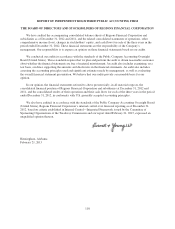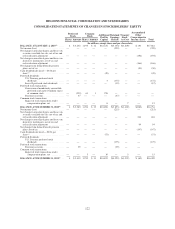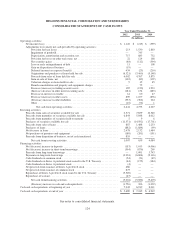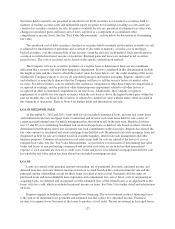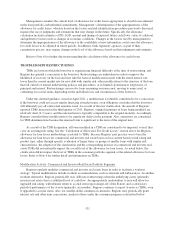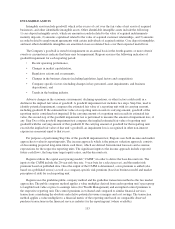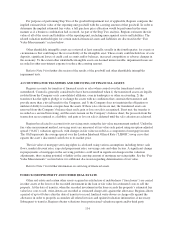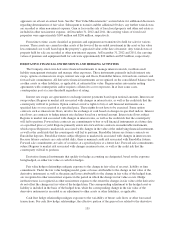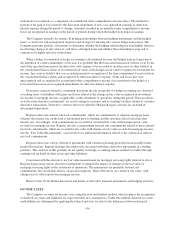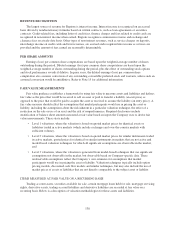Regions Bank 2012 Annual Report Download - page 144
Download and view the complete annual report
Please find page 144 of the 2012 Regions Bank annual report below. You can navigate through the pages in the report by either clicking on the pages listed below, or by using the keyword search tool below to find specific information within the annual report.is the sum of all lease payments (less non-recourse debt payments), plus estimated residual values, less unearned
income. Income from leveraged leases is recognized over the term of the leases based on the unrecovered equity
investment.
Commercial and investor real estate loans are placed on non-accrual if any of the following conditions
occur: 1) collection in full of contractual principal and interest is no longer reasonably assured (even if current as
to payment status), 2) a partial charge-off has occurred, unless the loan has been brought current under its
contractual terms (original or restructured terms) and the full originally contracted principal and interest is
considered to be fully collectible, or 3) the loan is delinquent on any principal or interest for 90 days or more
unless the obligation is secured by collateral having a realizable value sufficient to fully discharge the obligation
and the loan is in the legal process of collection. Factors considered regarding full collection include assessment
of changes in borrower’s cash flow, valuation of underlying collateral, ability and willingness of guarantors to
provide credit support, and other conditions.
Charge-offs on commercial and investor real estate loans are primarily based on the facts and circumstances
of the individual loan and occur when available information confirms the loan is not fully collectible and the loss
is reasonably quantifiable. Factors considered in making these determinations are the borrower’s and any
guarantor’s ability and willingness to pay, the status of the account in bankruptcy court (if applicable), and
collateral value. Commercial and investor real estate loan relationships of $250,000 or less are subject to charge-
off or charge down to estimated value less costs to sell at 180 days past due, based on collateral value.
Non-accrual and charge-off decisions for consumer loans are dictated by the Federal Financial Institutions
Examination Council’s (“FFEIC”) Uniform Retail Credit Classification and Account Management Policy which
establishes standards for the classification and treatment of consumer loans. Non-accrual status is driven by the
charge-off process as follows. If a consumer loan secured by real estate in a first lien position (residential first
mortgage or home equity) becomes 180 days past due, Regions evaluates the loan for non-accrual status and
potential charge-off based on net loan to value exposure. For home equity loans in a second lien position, the
analysis is performed at 120 days past due. If a loan is secured by collateral having a realizable value sufficient to
fully discharge the obligation, then a partial write-down is not necessary and the loan remains on accrual status,
provided it is in the process of legal collection. If a partial charge-off is necessary as a result of the evaluation,
then the remaining balance is placed on non-accrual. Consumer loans not secured by real estate are either 1)
charged-off in full at 120 days past due for closed-end loans, 180 days past due for open-end loans other than
credit cards or the end of the month in which the loan becomes 180 days past due for credit cards, or 2) partially
written down to estimated collateral value less estimated costs to sell no later than 120 days past due for home
equity second liens or at 180 days past due for residential and home equity first liens.
When a commercial or investor real estate loan is placed on non-accrual status, uncollected interest accrued
in the current year is reversed and charged to interest income. Uncollected interest accrued from prior years on
commercial and investor real estate loans placed on non-accrual status in the current year is charged against the
allowance for loan losses. When a consumer loan is placed on non-accrual status, all uncollected interest accrued
is reversed and charged to interest income due to immateriality. Interest collections on non-accrual loans are
applied as principal reductions. Regions determines past due or delinquency status of a loan based on contractual
payment terms.
All loans on non-accrual status may be returned to accrual status and interest accrual resumed if both of the
following conditions are met: 1) the loan is brought contractually current as to both principal and interest, and 2)
future payments are reasonably expected to continue being received in accordance with the terms of the loan and
repayment ability can be reasonably demonstrated.
ALLOWANCE FOR CREDIT LOSSES
Through provisions charged directly to expense, Regions has established an allowance for credit losses
(“allowance”). This allowance is comprised of two components: the allowance for loan and lease losses, which is
128


